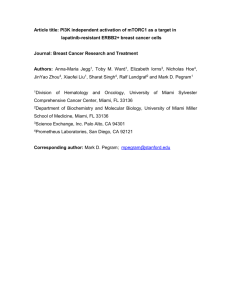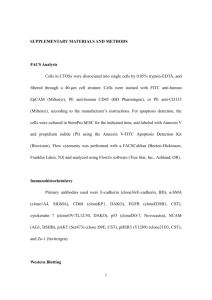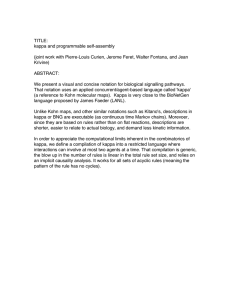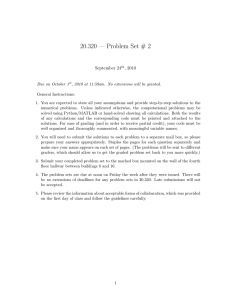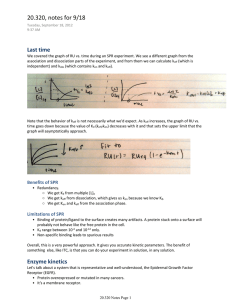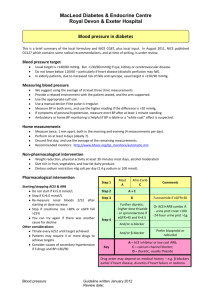20.320 Exam 1 Thursday October 4 , 2012 9:35-10:55
advertisement
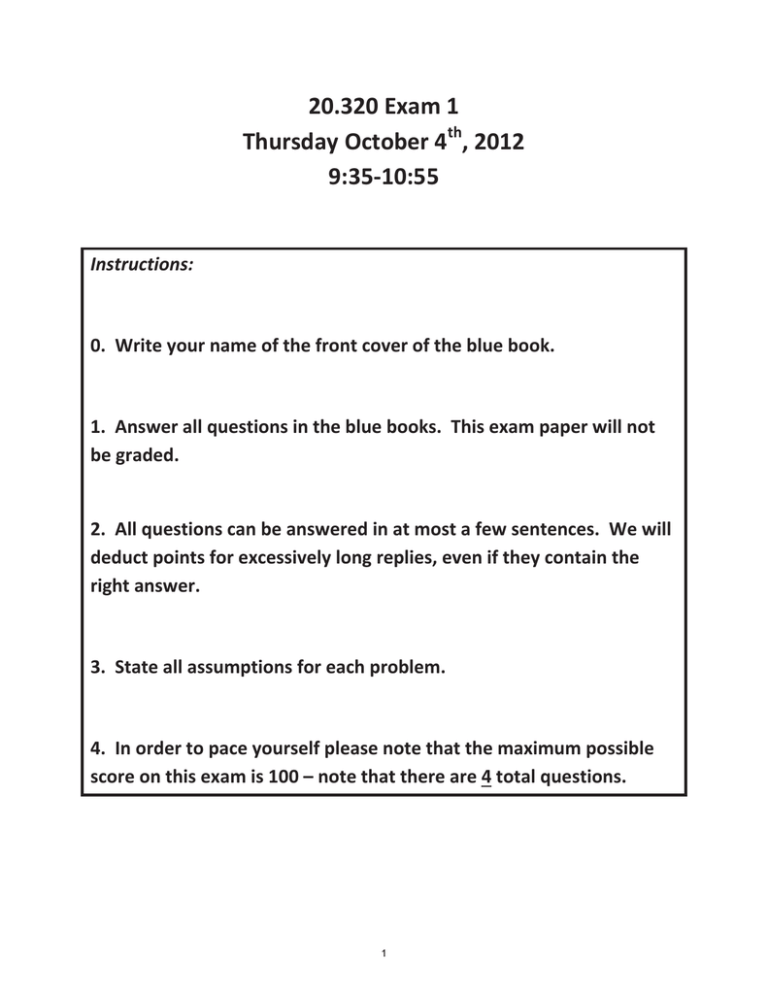
20.320 Exam 1 Thursday October 4th, 2012 9:35-10:55 � � Instructions: 0. Write your name of the front cover of the blue book. 1. Answer all questions in the blue books. This exam paper will not be graded. 2. All questions can be answered in at most a few sentences. We will deduct points for excessively long replies, even if they contain the right answer. 3. State all assumptions for each problem. 4. In order to pace yourself please note that the maximum possible score on this exam is 100 – note that there are 4 total questions. 1 Question 1. (25 points total) Bromodomains�are�protein�domains�that�bind�to�acetylated�lysines�(similar�to� SH21phosphotyrosine�interactions).��Jay�Bradner�at�Harvard�has�recently� developed�JQ11,�a�cell1permeable�small�molecule�(mass:�642�g/mol)�that�binds� and�inhibits�a�subset�of�bromodomains.��In�the�lab,�you�would�like�to�determine� the�affinity�between�JQ11�and�BrdX�(mass:�24,354�g/mol),�your�bromodomain�of� choice.��� A) (9�points)�Design�an�SPR�experiment�to�quantify�the�interaction�affinity� between�JQ1�and�BrdX,�including�proper�controls�and�which�molecule�is� immobilized.��The�details�of�exactly�how�SPR�works�are�not�critical�to� answer�this�question.�Justify�your�immobilization�selection�by�calculating� the�number�of�captured�molecules�needed�to�obtain�a�10�RU�signal�change� in�both�configurations.��(Note:��assume�a�10�mm2�chip�surface�area).� B) (10�points)�Given�the�following�parameters:�� kon�=�3x104�L�mol11�s11�� koff�=�4x1012�s11� How�long�will�it�take�to�complete�the�experiment�using�a�ligand� concentration�of�200�x�1019M,�assuming�the�association�reaches�90%�of�its� equilibrium�value�before�ligand�stops�and�90%�of�the�associated�ligand� dissociates�by�the�end�of�the�experiment?� C) �(6�points)�Although�SPR�is�a�very�powerful�approach,�it�does�have�some� limitations.��Provide�two�limitations�and�describe�how�you�would�know�that� they�are�affecting�your�measurements.� 2 Question 2. (25 points total) Overexpression�or�mutation�of�the�Epidermal�Growth�Factor�Receptor�(EGFR)�has� been�associated�with�a�broad�range�of�cancers.��As�discussed,�there�are�many� companies�that�have�developed�molecularly1targeted�therapeutics,�and�several�of� these�compounds�are�ATP�analogs�designed�to�inhibit�EGFR.��One�of�these� compounds,�Gefitinib,�is�currently�approved�for�lung�cancer�patients�with�high� EGFR�expression�or�with�selected�activating�mutations�in�EGFR.��Km�for�the�EGFR1 ATP�interaction�is�50x1016�M,�kcat�for�EGFR1ATP�is�106�sec11,�and�Ki�for�the�EGFR1 Gefitinib�interaction�is�22�x1019M.��ATP�concentration�in�the�cell�is�3�x1013M.������ a) (10�points)�Due�to�dose1limiting�toxicity,�the�intracellular�concentration�of� Gefitinib�is�limited�to�100x1019M.��How�effective�is�this�dose�at�shutting� down�EGFR�activity?� b) (4�points)�How�much�does�EGFR�inhibition�change�in�cells�expressing�106� copies�of�EGFR�versus�cells�expressing�104�copies�of�EGFR?� c) (4�points)�Why�is�a�strong�increase�in�expression�of�EGFR�often�associated� with�cancer,�even�in�the�absence�of�ligand�stimulation?�� d) (3�points)�Describe�how�the�mechanism�of�action�of�a�Type�II�inhibitor� differs�from�that�of�an�ATP�analogue.�� e) (4�points)�Given�a�cancer�cell�line�with�an�activating�EGFR�mutation,�would� you�use�a�Type�II�inhibitor�or�an�ATP�analogue�inhibitor�and�why?� 3 Question 3. (35 points total) As�discussed�in�lecture,�the�mitogen1activated�protein�kinase�(MAPK)�cascade�is� ultrasensitive,�demonstrating�very�strong�response�to�low1level�input.��Many� other�signaling�systems�also�feature�ultrasensitivity.�One�of�these�is�the�CDK1� (kinase)�1�CDC25�(phosphatase)�interaction,�which�regulates�the�cell�cycle.��In�a� recent�manuscript�(PNAS,�2012),�Lu�et�al.�developed�a�computational�model� describing�multi1site�phosphorylation�of�CDC25�by�CDK1,�where�the�multiply1 phosphorylated�CDC25�phosphatase�is�fully�active.��For�simplicity�in�this�model,� assume�2�CDK11dependent�phosphorylation�sites�on�CDC25.�In�the�parts�that� follow,�please�designate�CDK1�as�A�and�CDC25�as�B�and�use�the�nomenclature� from�class�to�describe�complexes�and�phosphorylated�species�(BP�is�B�that’s�been� phosphorylated�once,�BPP�is�double1phosphorylated).�Remember�to�state�your� assumptions!� A. (6�points)�Write�out�the�chemical�reactions�for�the�above�system.��You�can� start�with�phosphorylated,�activated�CDK1.� B. (12�points)�Write�out�ODEs�for�each�species.� C. (4�points)�What�are�the�key�points�in�this�system�that�lead�to� ultrasensitivity?� D. (3�points)��From�a�design�perspective,�how�could�you�increase�the� responsiveness�of�the�system?� E. (10�points)�One�of�the�substrates�of�CDC25�is�the�CDK1�kinase.��Add�this� reaction�into�your�system�and�add�in�the�additional�ODE(s)�reflecting�this� reaction.��What�biological�principle�does�this�introduce�into�the�system�and� why�is�it�useful.�� � 4 Question 4. (15 points total) Short answers – one to three sentences. a) (3�points)��Describe�what�information�you�can�obtain�from�ITC�and�not�from� SPR�and�vice�versa.�� b) (3�points)��How�does�strong�positive�feedback�affect�the�duration�and� amplitude�of�the�kinase�signaling�cascade?���� c) (3�points)�Name�one�reason�why�the�quantitative�interaction�affinities�and� kinetics�generated�by�surface�plasmon�resonance�(SPR)�may�not�be� applicable�to�modeling�reactions�in�cells.� d) (3�points)�Describe�the�pseudo�first�order�approximation�(PFOA).�Is�this� applicable�in�ITC�and�SPR?�Why�or�why�not.�� e) (3�points)�Describe�one�technique�that�can�be�used�to�determine�if�two� proteins�interact�in�vitro.�� � �� 5 MIT OpenCourseWare http://ocw.mit.edu 20.320 Analysis of Biomolecular and Cellular Systems Fall 2012 For information about citing these materials or our Terms of Use, visit: http://ocw.mit.edu/terms.
